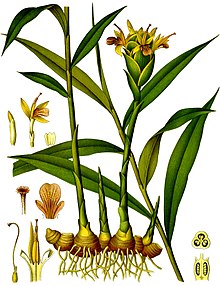
Back Halia ACE Gemmer Afrikaans ዝንጅብል Amharic Adiyam AMI Zingiber officinale AN Gingifer ANG زنجبيل Arabic ܚܡܣܐ ARC جنزبيل ARZ আদা Assamese
| Ginger | |
|---|---|

| |
| 1896 color plate from Köhler's Medicinal Plants | |

| |
| Inflorescence | |
| Scientific classification | |
| Kingdom: | Plantae |
| Clade: | Tracheophytes |
| Clade: | Angiosperms |
| Clade: | Monocots |
| Clade: | Commelinids |
| Order: | Zingiberales |
| Family: | Zingiberaceae |
| Genus: | Zingiber |
| Species: | Z. officinale
|
| Binomial name | |
| Zingiber officinale | |
Ginger (Zingiber officinale) is a flowering plant whose rhizome, ginger root or ginger, is widely used as a spice and a folk medicine.[2] It is an herbaceous perennial that grows annual pseudostems (false stems made of the rolled bases of leaves) about one meter tall, bearing narrow leaf blades. The inflorescences bear flowers having pale yellow petals with purple edges, and arise directly from the rhizome on separate shoots.[3]
Ginger is in the family Zingiberaceae, which also includes turmeric (Curcuma longa),[4] cardamom (Elettaria cardamomum), and galangal. Ginger originated in Maritime Southeast Asia and was likely domesticated first by the Austronesian peoples. It was transported with them throughout the Indo-Pacific during the Austronesian expansion (c. 5,000 BP), reaching as far as Hawaii. Ginger is one of the first spices to have been exported from Asia, arriving in Europe with the spice trade, and was used by ancient Greeks and Romans.[5] The distantly related dicots in the genus Asarum are commonly called wild ginger because of their similar taste.
Ginger has been used in traditional medicine in China, India and Japan for centuries, and as a dietary supplement. There is no good evidence that ginger helps alleviate nausea and vomiting associated with pregnancy or chemotherapy, and its safety has not been demonstrated.[6][7] It remains uncertain whether ginger is effective for treating any disease, and use of ginger as a drug has not been approved by the FDA.[8] In 2020, world production of ginger was 4.3 million tonnes, led by India with 43% of the world total.
- ^ "Zingiber officinale". Germplasm Resources Information Network. Agricultural Research Service, United States Department of Agriculture. Retrieved 10 December 2017.
- ^ "Ginger, NCCIH Herbs at a Glance". US NCCIH. 1 December 2020. Retrieved 4 September 2023.
- ^ Sutarno H, Hadad EA, Brink M (1999). "Zingiber officinale Roscoe". In De Guzman CC, Siemonsma JS (eds.). Plant resources of South-East Asia: no.13: Spices. Leiden (Netherlands): Backhuys Publishers. pp. 238–244.
- ^ "Curcuma longa L." Plants of the World Online, Kew Science, Kew Gardens, Royal Botanic Gardens, Kew, England. 2018. Retrieved 26 March 2018.
- ^ Cite error: The named reference
Kewwas invoked but never defined (see the help page). - ^ Cite error: The named reference
pregwas invoked but never defined (see the help page). - ^ Cite error: The named reference
chemowas invoked but never defined (see the help page). - ^ Cite error: The named reference
drugswas invoked but never defined (see the help page).